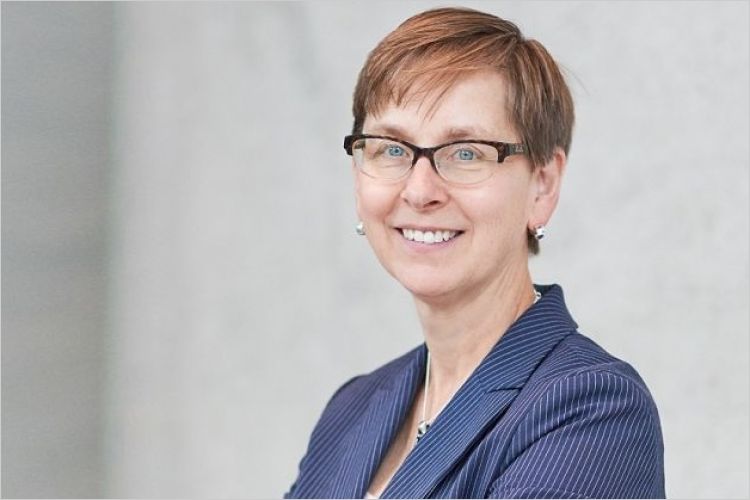
Monica Curtis became Senior Director of the Pembina Institute's Communities and Decarbonization group on February 5. This group encompasses three programs: Buildings, Equitable Transition, and Transportation.
Monica is committed to delivering emission reductions and saved energy that also bring social benefits. She leverages over 20 years’ experience helping governments, institutions, businesses, and utilities build the case for improved energy use through the adoption of energy efficiency, renewable energy, clean technology, and efficiency financing in a range of regulatory jurisdictions across North America. She has worked with organizations across Canada, including EnerQuality, Energy Efficiency Alberta, EPCOR and SaskPower, and with a leader in efficiency programs based in Madison, Wisconsin. She currently serves on several governing and advisory councils. Monica was recognized as a 2019 Compelling Calgarian and as one of Canada’s Clean 50 for 2020.
Select career highlights:
While she was Chief Executive Officer at Energy Efficiency Alberta, she oversaw the implementation of a suite of demand side management and onsite renewable energy services that delivered $800M in lifetime energy savings and emissions reductions to Alberta business and residents, enabled $559M in private sector investment, and created 5170 jobs for Albertans.
At Energy Finance Solutions (EFS), where she held several senior leadership positions, the program expanded in New York and Midwest. EFS delivers white-label underwriting, in one year closing ~US$125M in residential loans to support rooftop solar and whole house retrofits across multiple states and launching Commercial PACE (Property Assessed Clean Energy) in Wisconsin.
Laurence: Tell me a bit about the experience that has led you to becoming the senior director of the Communities and Decarbonization group at the Pembina Institute? What have been some of the significant turning points in your career?
Monica: I have had the good fortune to design, deliver and evaluate energy efficiency and decarbonization initiatives across Canada and the US. The common thread has been managing building energy use to deliver high building performance in terms of comfort and use, while reducing operating costs and environmental impacts. Reducing and managing energy end-uses provides value to building owners and operators, from industrial plants to the family home, and offers utilities additional tools to ensure a reliable and cost-effective electricity service.
Laurence: What are the strengths and priorities of the team that you’ll be leading that you want to build on?
Monica: The greatest strengths of this team are their hope for a low-carbon future and their commitment to finding and presenting solutions. I look forward to leveraging the diverse expertise and skills sets of the team to advance the learnings so far, accelerate the research in progress, and further engage the building and transportation sector.
Laurence: You have a vision for buildings and transportation as systems that need to be increasingly integrated with the help of a highly skilled workforce in order to achieve net-zero. Can you provide a high-level overview of what you mean by that?
Monica: Buildings and vehicles are primary end-uses of energy in our economy. Energy efficient buildings reduce the total amount of energy needed; on-site renewables provide local, no- or low-carbon energy resources; energy management systems enable a building to shift the time and intensity of various energy uses; electric vehicles and other battery sources provide an infrastructure to store electricity. These are examples of the technologies that can enable buildings and transportation systems to move from simply “taking” energy to becoming an integrated part of the utility system. Technology pathways exist to achieve net-zero energy and low-carbon. New business models and a workforce with the skills and experience to design, build and operate these systems are needed to implement emerging (and sometimes long proven) technologies that deliver net zero results.
Laurence: What are some of the examples you’ve seen in Canada and the United States that demonstrate how we can develop energy resources in such a way as to contribute to net-zero?
Monica: Let me provide two examples. Utility demand side management (DSM) is a well-established feature of the US electricity industry. Program participants are paid for the value of reducing or shifting energy use provided to utility system. The price is set through transparent regulatory processes, calculated based on internationally recognized protocols for saved energy and carbon emissions. While Alberta is the only jurisdiction in Canada that does not enable utility DSM, most Canadian jurisdictions could benefit from increased transparency and mechanisms to separate utility DSM from public policy objectives such as low-income subsidies.
Moving on to buildings: two common reasons commercial building owners do not invest in net-zero technologies are, firstly, the time owners expect to hold the asset is less than the payback period for the technologies, and, secondly, split incentives, where the owner provides the capital, and the tenant receives the utility bill savings. Commercial Property Assessed Clean Energy (C-PACE) is a financing mechanism that enables commercial building owners to align repayment schedules to the value of the energy and emissions savings. Financing tools that make it is easy and cost-effective for buildings and fleets to choose net zero technologies are needed. C-PACE is one example that has been successfully used in select sectors in the US.
Laurence: Are there particular strengths Canada can lean into as we decarbonization our economy and infrastructure?
Monica: Canada has a long history in building science and leading expertise in cold climate buildings. These fundamentals are key to building the next generation of net zero buildings and communities.
What’s more, provinces and the federal government are making investments in innovation. There is a robust network of technology accelerators with a focus on clean tech and financial tech as well as a (small but) growing philanthropic sector. And while private corporation’s investment lags international standards, there are industry leaders investing in local research and development. This creates opportunity to accelerate adoption of emerging technologies to achieve net zero.
Laurence Miall is communications manager for the Pembina Institute's communities and decarbonization work; he is based in Edmonton.



